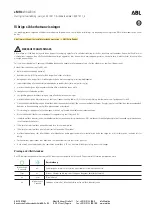
19
5.5.1.3 Charging current limitation (default setting 75%)
For maximum battery life, a charging current of 10% to 20% of the capacity in Ah should be applied.
Example: optimal charging current of a 24V/500Ah battery bank: 50A to 100A.
The temperature sensor supplied automatically adjusts the charging voltage to the battery temperature.
If faster charging – and a subsequent higher current – is required:
- the temperature sensor supplied should be fitted to the battery, since fast charging can lead to a considerable temperature rise of the
battery bank. The charging voltage is adapted to the higher temperature (i.e. lowered) by means of the temperature sensor.
- the bulk charging time will sometimes be so short that a fixed absorption time would be more satisfactory (‘fixed’ absorption time, see
ds5, step 2).
Procedure
The battery charging current can be set in four steps, using DIP switches ds4 and ds3 (default setting: 75%).
ds4 ds3
off off = 25%
off on = 50%
on off = 75%
on on = 100%
5.5.1.4 Stand-alone, parallel and 3-phase operation
Using DIP switches ds2 and ds1, three system configurations can be selected.
NOTE:
•
When configuring a parallel or 3-phase system, all related devices should be interconnected using RJ45 UTP cables (see
appendix C, D). All devices must be turned on. They will subsequently return an error code (see Section 7), since they have
been integrated into a system and still are configured as ‘stand-alone’. This error message can safely be ignored.
•
Storing settings (by pressing the ‘Up’ button (step 1) – and later on the ‘Down’ button (step 2) – for 2 seconds) should be
done on one device only. This device is the ‘master’ in a parallel system or the ‘leader’ (L1) in a 3-phase system.
In a parallel system, the step-1 settings of DIP switches ds2 to ds8 are not relevant for the other devices, i.e. the slaves,
which follow the master exactly (hence the master/slave relationship).
In a 3-phase system, a number of settings are required for the other devices, i.e. the followers (for phases L2 and L3).
(The followers, therefore, do not follow the leader for all settings, hence the leader/follower terminology).
•
A change in the setting ‘stand-alone / parallel / 3-phase’ is only activated after the setting has been stored (by pressing the
‘UP’ button for 2 seconds)
and
after all devices have been turned off and then on again. In order to start up a VE.Bus
system correctly, all devices should therefore be turned off after the settings have been stored, They can then be turned on
in any order. The system will not start until all devices have been turned on.
•
Note that only identical devices can be integrated in one system. Any attempt to use different models in one system will fail.
Such devices may possibly function correctly again only after individual reconfiguration for ‘stand-alone’ operation.
•
The combination
ds2
=on and
ds1
=on is not used.
Содержание Quattro 12/5000/200
Страница 30: ...29 APPENDIX A Connection overview ...
Страница 32: ...31 APPENDIX B Block diagram ...
Страница 33: ...32 APPENDIX C Parallel connection ...
Страница 34: ...33 APPENDIX D Three phase connection ...
Страница 37: ...36 APPENDIX G Dimensions ...
















































